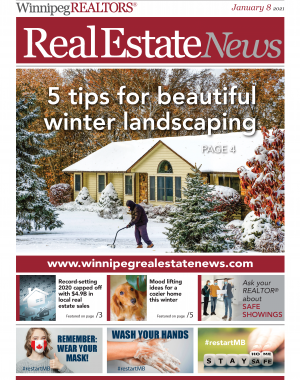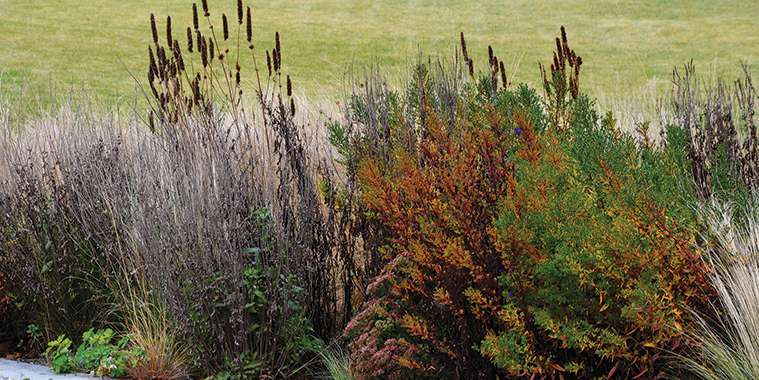Seasoned gardeners will tell you landscaping is far from seasonal.
Designing a backyard that pops throughout the year requires careful consideration to ensure everything rotates in turn with the Earth’s axis. Consider the simple concept of a snow globe. The scene is serene when all is calm — and even more magical when shaken up with falling snow.
Instead of feeling discouraged by our gardens being buried in snow, it’s time to rethink the winter season — it’s an opportunity to shift focus. Visual interest can be achieved by integrating ornamental grasses, trees and hardscaping. In fact, you’ll find these five tips will allow you to show off your property in an unexpected way. Rain, snow, sleet or shine!
1. Evergreens
Evergreens are a bit of a misnomer. Typically, they’re easy to identify as their foliage remains green year-round. However, evergreens can also be yellow, like the feathery Gold Thread False Cypress or semi-weeping Cypress Gold Mop. Plant either in full sun and they will turn a rich gold.
In shady areas, the foliage will remain lime green. Evergreens can also be blue, like the blue spruce which is a popular choice for both accent and privacy screening. Evergreens are low-maintenance, resilient and offer staggering focal points in a yard or garden. A whimsical choice would be the Birds Nest spruce, a shrub that grows in a compact ball. It has a characteristic depression in its centre, like a bird’s nest.
Boxwood hedge and English Boxwood will also ride out a heavy snow load and keep your garden green!
2. Bark
Depending on your province and growing zone, consider planting winter-blooming tree species. The Red Twig Dogwood remains blood red year-round, painting a remarkable contrast against the snow. It’s also a favoured addition to planter boxes to complement lengths of birch trees and cedar branches.
Ornamental trees like birch and sycamores offer texture and height while providing seeds and shelter for birds.
3. Hardscaping
There’s nothing hard about it, really! Hardscaping includes all the man-made features used in backyard design, balanced by vegetation. It includes pathways, stone walls, trellises, arbours and benches. Sculptures, colourful birdhouses and fire pits also act as strong visual cues of warmer days ahead! Outdoor lighting, playful potting sheds and treehouses make hardscaping flexible and easy. It’s amazing how an ordinary bird feeder can take on a sculptural affect when piled with fresh snow. Visit your favourite parks and gardens for inspiration.
4. Berries
Birders and berries are simpatico. Tree and shrub varieties that bear berries will automatically attract overwintering birds (and early migrators come spring). Barberry and Cotoneaster are gorgeous considerations, while the berries of the Mountain Ash will persist on the tree all winter. Birders (and birds) note the ‘Leonard Springer’ variety of ash is not popular on their menu.
The Snowdrift crabapple dazzles with a mass of snow-like flowers in early spring and the orange-red fruit hangs well into winter for wildlife to enjoy like a back alley food truck. Winterberry holly is also a pleasing choice and enjoyed indoors and out. The shrub loses its leaves in autumn to reveal thousands of bright berries that hang like holiday ornaments. Snowberry shrubs are loved for their white bulbs and berries which appear in autumn and last into winter.
5. Four-season perennials
Perennials are like the bears of the plant world. They simply rest during the freeze/thaw cycle, but still add visual interest, especially if their seed heads are left intact. Sedum varieties like “Dragon’s Blood” turn red in autumn and add colour when winter’s white palette dominates.
Ornamental grasses are useful for privacy from neighbours and a natural accessory. Grasses left to stand throughout the winter also act as an abundant seed supply for birds. Sunflowers, asters and zinnias serve the same useful purpose.
Hellebores will surprise with a burst of colour sometimes as early as December while other perennials lie dormant. The Christmas Rose cultivar pops with white flowers that can turn deep pink throughout the winter.
Perennials that bounce back in spring in a bigger and better way include hostas, peonies (trim dead foliage in fall to ensure big blooms come spring), Wild Columbine and Bee Balm.
As you incorporate these ideas into your property, remember that the first day of spring is March 20, 2021. We’ll get there soon enough, so enjoy your revamped winter landscape — it’s the only time we don’t have to worry about weeds!
— Realtor.ca



